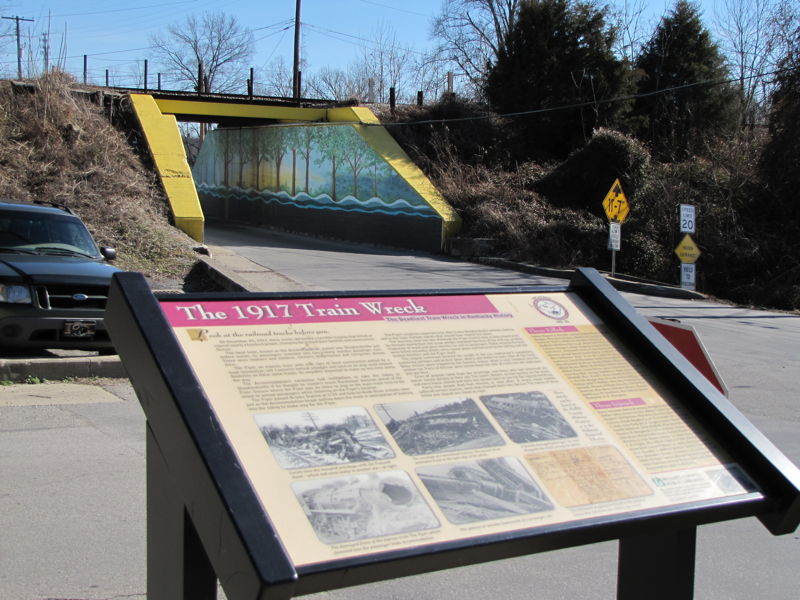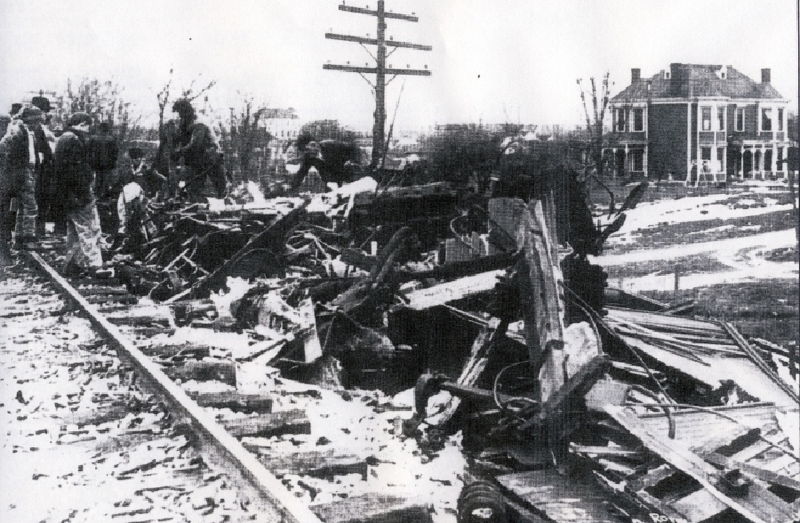
The following article by Charles Hartley originally appeared in The Courier-Journal on 8 Feb 2012. It is archived here with additional information for your reading enjoyment.
Vehicles pass daily through the railroad underpass on Joe B. Hall Avenue in Shepherdsville, but most people are unaware of the tragedy that occurred here more than a century ago.
On the tracks above this underpass sat a local passenger train on December 20, 1917, its passengers unaware that a larger express train was bearing down on them.
Today an historical marker sits outside the Ridgway Memorial Library, silent testimony to the terrible crash that took the lives of forty-nine people and injured that many more in the worst train disaster in Kentucky history.

Christmas was fast approaching and a fierce snow storm had delayed preparations. Now, with the snow thawing, people from Springfield, Bardstown, Shepherdsville and other places up and down the line boarded the morning train, headed for Louisville to do their Christmas shopping, or handle some last minute business. None could know what horror awaited them on their journey home.
This local passenger train, called the "Accommodation," included a baggage car and the "smoker" car, followed by the day coach which mostly accommodated ladies, their husbands, and a handful of gentlemen who wished to avoid the tobacco smoke in the other car. These coaches were largely constructed of wood built on a metal chassis.
The larger oncoming express train, known as the Flyer, included a larger locomotive and nine passenger cars, mostly constructed of steel. It was running behind schedule and trying to make up time.
Because of miscommunications, the Accommodation's conductor and engineer were not sure how close the Flyer was, and the engineer of the Flyer did not know the Accommodation was sitting on the tracks in front of him until it was too late to stop.
The Accommodation train was almost ready to back into a siding when its passengers heard the terrible screeching of the Flyer's braking wheels, and the next moment felt the impact of its engine crashing into their coach.
Dr. John Gilmore Dodds, a surviving passenger, later told a reporter, "There was no apparent slacking of the train's speed, and no jarring crash. Suddenly the car began to fold up from the giant force pushing from behind. I found myself rolled in a ball in one corner with screaming women and men piled about me."
The Flyer's forward momentum and great weight imploded the back of the car sending fragments of wood and glass forward into the car and its passengers. As it continued forward the sides of the car buckled and shattered, causing the roof to drop down on passengers' heads.
Some of the passengers nearest the point of impact were killed instantly, never knowing what hit them. Others were battered about, suffering life-threatening injuries. The engine continued forward the length of the car, shattering it completely, and scattering splinters and broken glass debris and bodies to both sides of the track. Other bodies were trapped on the massive engine when it next smashed into the smoker car, where its momentum stalled about half way through the car. That car was pushed forward into the baggage car which was also damaged as it was caught in a vise between the smoker and the engine. Parts of both cars fell down the side of the track into the small underpass near the Trunnell Hotel, a building the still stands today, the home of the law offices of McAfee, Rakes, Miller, and Brockman.

Those who witnessed the crash moved quickly to help. The town's three doctors were on the scene in a few minutes and every house and store was thrown open to care for the dead and dying. Poor light hampered rescue along the track, making it difficult to locate silent victims.
Local doctors worked feverishly to aid the injured until a relief train arrived from Louisville carrying doctors and medical supplies. The more seriously injured were taken by train to a Louisville hospital.
In December 2007, and again in 2017, memorial events was held in the Bullitt County. Many who attended were descendants of the train wreck victims.
Information about our book on the train wreck is available here.
Copyright 2019 by Charles Hartley, Shepherdsville KY. All rights are reserved. No part of the content of this page may be included in any format in any place without the written permission of the copyright holder.
The Bullitt County History Museum, a service of the Bullitt County Genealogical Society, is located in the county courthouse at 300 South Buckman Street (Highway 61) in Shepherdsville, Kentucky. The museum, along with its research room, is open 10 a.m. to 4 p.m. Monday through Friday. Saturday appointments are available by calling 502-921-0161 during our regular weekday hours. Admission is free. The museum, as part of the Bullitt County Genealogical Society, is a 501(c)3 tax exempt organization and is classified as a 509(a)2 public charity. Contributions and bequests are deductible under section 2055, 2106, or 2522 of the Internal Revenue Code. Page last modified: 12 Sep 2024 . Page URL: bullittcountyhistory.org/memories/trainwreck.html